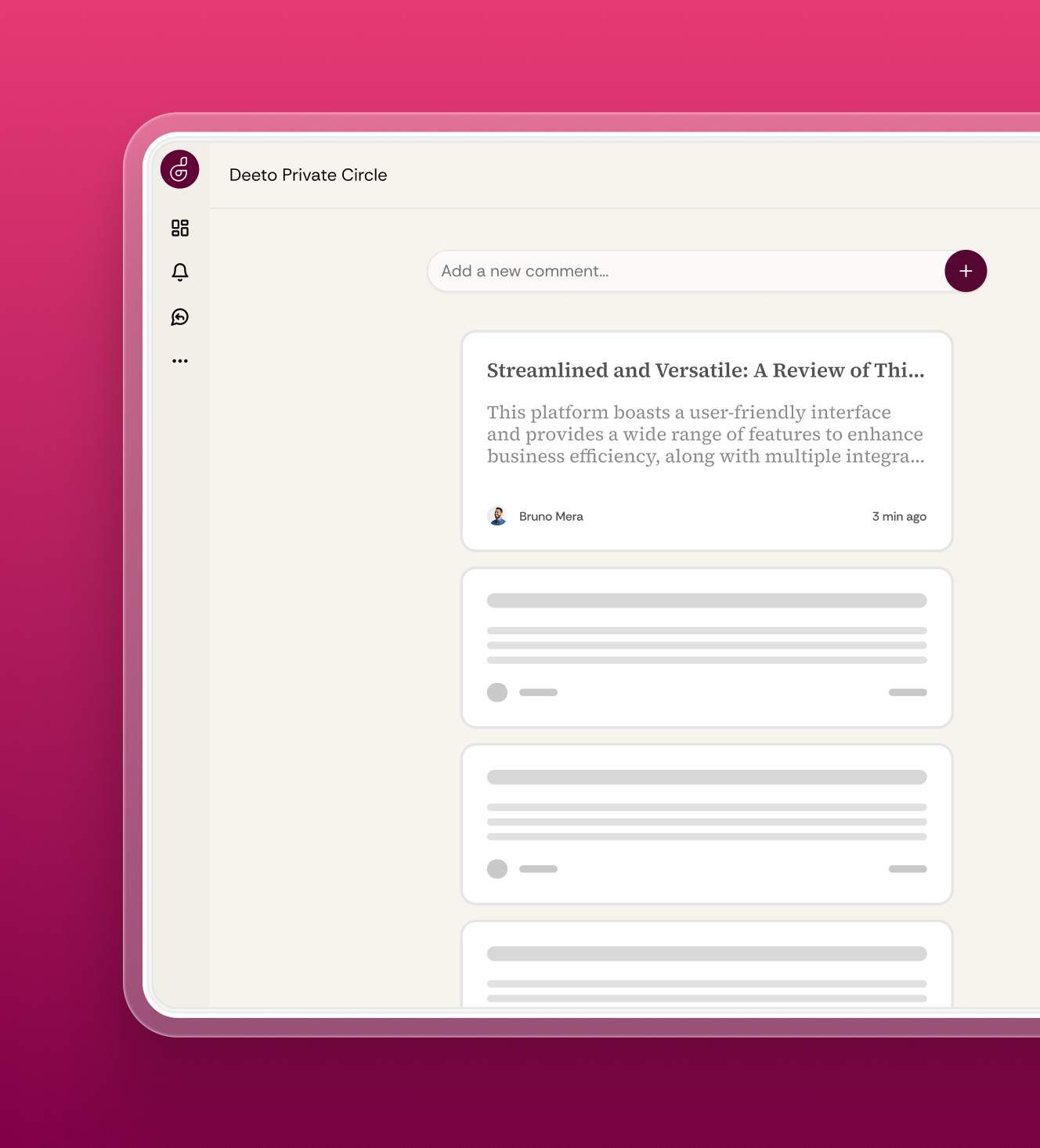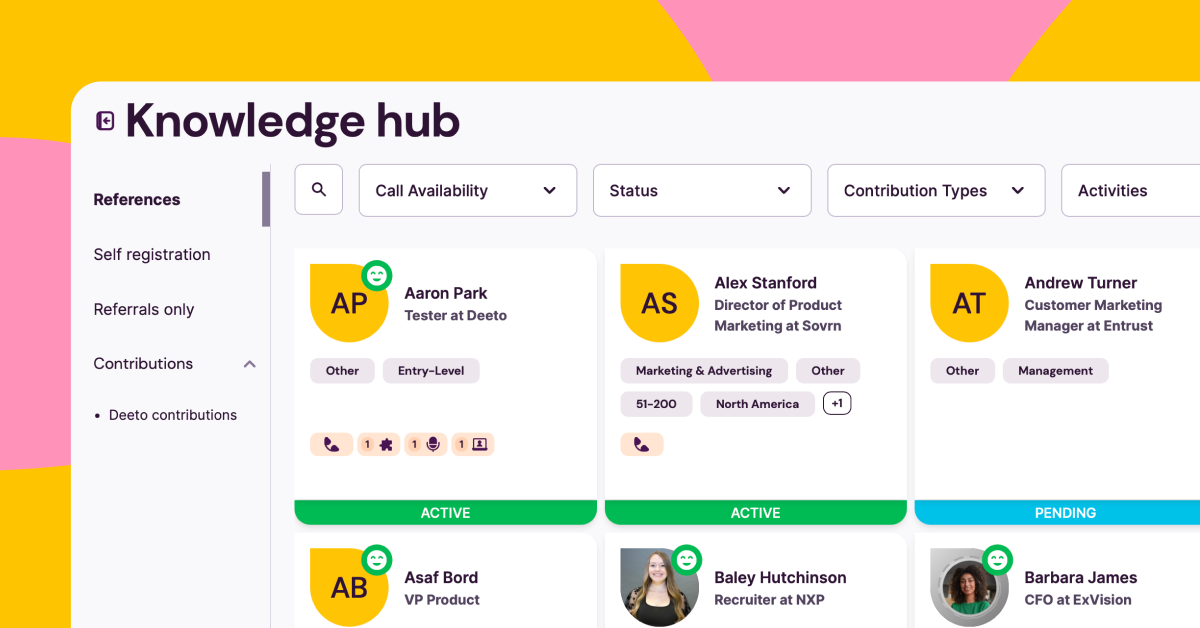
Welcome to the Deeto Hub
A resource and community space for modern marketers, sellers, and builders using customer voice to grow — together.

A resource and community space for modern marketers, sellers, and builders using customer voice to grow — together.
This hub is built for anyone who wants to do more with the voices of their customers. Whether you're scaling advocacy, building trust with proof, or rethinking how to go to market — you're in the right place.
How-to guides and playbooks for building with customer voice
Campaign-ready templates and swipe files
Benchmark reports and reference best practices
Event recordings, expert sessions, and community spotlights
Ask questions. Share ideas. Trade wins. This is your space.
You don’t have to figure this out alone. The Deeto community connects you with other leaders using customer voice to build better GTM motions, faster-growing brands, and smarter strategies. If you are interested in joining when it launches, sign up below.
Automate advocacy management workflows
Dynamically generate customer stories and social proof
Eliminate manual reference management
Track and report advocacy impact on revenue

Discover practical guides, templates, and tools to help your team close more deals, faster.
If you're building out a sales team, you're either going to hire sales development representatives (SDRs) or business development representatives (BDRs).
Chances are, you've heard both terms thrown around quite a bit (at times, seemingly interchangeably). While they sound similar, their distinction is important when it comes to hiring decisions. Each position requires a unique set of behaviors, skills, and performance metrics.
Hiring the wrong type of sales rep causes confusion over responsibilities, inefficiencies in your sales pipeline, and underperformance if someone lacks the core strengths for the specific function.
In today's article, I'll walk you through the SDR's and BDR's roles within a company, their key differences, and how to know which one you need to hire for your sales org.
An SDR, or Sales Development Representative, is the person in your sales organization who identifies, qualifies, and engages potential customers before handing them off to an Account Executive or a more senior sales rep. Think of them as a “first point of contact” who breaks the ice with interested prospects.
Typically, they:
The SDR role engages and nurtures warm leads. They set the stage for more meaningful conversations down the line.
A BDR, or Business Development Representative, is your go-to person for finding untapped business opportunities and sparking conversations with companies that may not even know they need your solution yet. While an SDR deals with warm leads and inbound inquiries, a BDR is the hunter who goes out to create opportunities from scratch.
Some of their key responsibilities include:
BDRs expand your company's market reach by bringing new leads into your funnel. They get your product on the right people's radar, even before they start actively looking for a solution.
The main difference between an SDR and a BDR is that SDRs are focused on inbound leads, while BDRs are focused on outbound sales.
The number-one goal of sales development is to set qualified appointments with prospects who have a strong chance of converting into customers. Someone who meets this criteria is classified as a sales-qualified lead (SQL).
Business development, on the other hand, exists to create net-new revenue opportunities. The BDR's ultimate goal is to broaden the company’s horizons through fresh channels, business partnerships, and market segments.
Let's take a look at those differences more in-depth:
They’re looking for companies or markets you haven't fully tapped into yet (if at all). They start by identifying decision-makers and their roles/titles, then apply their knowledhe of industry trends, to figure out which companies stand to benefit the most from your offering. They base their outreach on simple identifiers like company size, location, and vertical.
Since the people they’re reaching out to haven’t necessarily raised their hands, BDRs start at a more basic level of qualification — that is, confirming whether there’s even a need for your product or service. By starting a conversation, they're essentially gauging (a) whether the prospect fits your ICP and (b) if the timing is right to move forward.
SDRs primarily focus on the people who’ve already shown interest in some way, like downloading a white paper, attending a webinar, or filling out a form. These leads are a step or two closer to buying, so SDRs don’t have to comb through entire industries. Instead, they talk with people who come in through existing marketing efforts (e.g., an ad or blog post).
Because of this, qualification is all about determining if that existing interest is a genuine fit. They can delve deeper into how the prospect’s challenges align with your solution and whether the lead meets your company’s “sales-ready” criteria. If the lead checks those boxes, the SDR sets up an appointment or demo with an Account Executive to keep the conversation rolling.

BDRs' prospects aren’t actively looking for a solution, so they spend time researching both the company and key stakeholders to create highly relevant messages that stand out. From there, they use cold outreach strategies to
Building relationships from scratch takes time — it takes an average of 8 touchpoints to land an intial meeting. So BDRs also develop a sales cadence (a planned sequence of outreach activities) that combines emails, calls, and social media outreach at strategic intervals.
Inbound leads are “warm,” so SDRs respond quickly (often within minutes or hours) to capitalize on that initial interest. Since these leads have already engaged (e.g., by requesting info), they focus on confirming fit and readiness rather than persuading someone to explore a solution from zero.
While the conversion cycle is shorter, SDRs still use a combination of phone calls, emails, and digital follow-ups to keep leads engaged and move them toward a productive conversation with an AE.
There are three main ways BDR managers measure and evaluate their teams:
As for sales development reps, activity metrics like call volume are also important. But, since they're dealing with warmer prospects, there are three other critical metrics to pay attention to:
A BDR's prospects might be aware your product exists, but they (usually) aren't actively looking for a solution. The BDR's job is to get them interested. They're there to get the prospect talking about their challenges and see if there's a way your product can help.
SDRs bridge the gap between marketing and sales. Their prospects have already looked at some of your marketing content and are somewhat familiar with your product. Some might even have requested a demo or trial. In this case, the BDR's job of filling the top of the funnel has already been taken care of by your marketing activities.
SDRs and BDRs are both part of an inside sales team. Both roles do the “pre-work” before the heavier sales discussions happen. And both hand off their leads to an AE, who picks up to do demos, negotiate deals, and close business.
Beyond this, there are plenty of opportunities for them to collaborate:
BDRs might come across a promising new segment during outbound efforts and can pass that insight to SDRs, who use it to tweak their follow-up and qualification methodology. SDRs, who hear firsthand what inbound leads are responding to, share tactics and hooks that resonate.
Sometimes a BDR uncovers a highly interested lead who’s actually an inbound lead that slipped through the cracks. And if a lead is initially cold for a BDR but later engages with a webinar or downloads a white paper, that might shift it into SDR territory.
SDR and BDR teams share the ultimate goal of growing and maintaining a solid pipeline. AEs share with both groups what happened post-handoff — was the opportunity a good fit, and if not, why?— so both can refine their targeting.
When you’re deciding whether to hire an SDR or a BDR first (or at all), it really comes down to what your current pipeline looks like, how established your brand is, and the nature of your sales process.
Broadly speaking, there are five factors that will influence your decision:
If you already have a lot of inbound leads thanks to marketing, brand recognition, or a customer advocacy program, an SDR is ideal. If you’re still making a name for yourself, a BDR will cold call and educate the market. They'll set up initial conversations that drive early adoption.
Complex deals require a higher degree of personalization and strategic outreach that's right within the wheelhouse of a BDR. If your solution is easier to understand and the sales cycle is shorter, an SDR should be enough to qualify inbound interest.
If you're already pulling tons of leads from different marketing channels, an SDR can slot in to convert them into qualified prospects. If your marketing function is lean, a BDR can generate fresh opportunities without relying on a heavy marketing funnel.
BDRs are more expensive in the sense that outbound prospecting campaigns take longer to yield results. There’s also a lot of time and effort in building target lists, crafting outreach sequences, and refining messaging. SDRs show quicker ROI because they capitalize on your existing inbound momentum.
If your goal this year is to break into a new industry vertical or geographic region, a BDR is the one who'll spearhead that effort. If your marketing is already effective at driving people to your site or product demos, an SDR will make sure no lead falls through the cracks.
Today's customers want convenience and personalization. Internally, software helps you streamline your processes, keep everything organized, and tailor each sales conversation to the individual you're working with.

CRM is the core system your sales force will be working in. It handles just about everything:
It also integrates bi-directionally with all your other tools. For instance, when a lead comes through your marketing automation platform, it auto-syncs that info with your CRM as a contact record to follow up on.
Sales automation tools eliminate manual work from different aspects of the BDR and SDR workflow.
These are just a few examples of different tools with automation features that enhance your SDRs' and/or BDRs' productivity.
For instance, you can use Deeto to build personal mircosites for different kinds of prospects and increase top-of-funnel intent. Instead of sending a regular old email, you can send them a persona-based web page with relevant USPs and user-generated content.
Your tools are constantly collecting data from selling activities, customer engagement, and transactions.
CRM tells you everything you need to know about your pipeline and SDR/BDR performance. That includes things like:
Sales automation tools provide similar reporting but with a more granular level of detail.
You also have platforms like Deeto, which monitors opportunities and evaluates advocates' and references' impact on lead generation, opportunity progress, and conversions, and shows you which customer segments or industries are most likely to become advocates for your product.
Today, a significant majority of sales teams have integrated AI into their operations. Salesforce's sixth State of Sales report found that 81% of sales orgs are either testing or already using AI tools. McKinsey's global State of AI survey supports this, showing 78% of organizations use AI, with marketing and sales among the most common areas of application.
It's worked its way into just about every facet of the selling process:
Deeto's AI even analyzes a lead's profile and gives sellers personalized UGC and social proof. That way, reps have an easier time qualifying leads, and they share relevant content that addresses buyer pain points right off the bat.

While the role of the sales rep (BDR or SDR) is a critical one, the fact of the matter is that fewer and fewer buyers are interested in interacting with them. According to research from Gartner, 75% say they prefer a rep-free experience altogether.
The reason is that they prefer to do their own research — 85% of buyers trust customers in their industry more than any other source of information, and they've completed 70% of the decision-making process by the time they engage someone from the company.
Deeto facilitates a more customer-led sales process. You can use it to gather customer feedback and social proof, distribute it across your sales and marketing channels, build a reference pool, and match relevant customer experiences to target accounts.
Request a demo to see how it works.

Explore SDR vs. BDR roles: learn their distinct tasks, goals, & when to use each. Master sales strategies!
Thanks to generative AI, you can mass-produce virtually any type of content: blog posts, sales emails, even full-on case studies.
Now...solely relying on AI for customer engagement is a recipe for disaster. In 2023, 92% of companies said they use AI-driven personalization in marketing and sales, but the key word here is “driven.”
Those who use it successfully aren’t replacing their team with it — they’re using it to 10x their team’s productivity and deliver personalized experiences to more customers at once.
To successfully use AI in your sales, marketing, and customer success efforts, you have to know where you need that human touch, and how AI can supplement that.
According to McKinsey, nearly three-quarters of all customers expect companies to give personalized interactions. And for B2B buyers, 80% of them expect a B2C-like experience when it comes to personalized content and seamless interactions with your company.
Your team members are there to lay the groundwork:
It's on your sales team to build relationships with potential customers and convert them. And it's on your CS team to activate your cusotmer base and turn them into advocates. If you don't take the time to get to know your users, AI won't be able to bridge that gap.
B2B sales involve multiple decision-makers (all with different needs). They have long sales cycles that require a different approach at each stage, and negotiations are complicated.
Your sales team needs to know which content, customer references, and data points to use for each member of the buying group at each step of the process.
While AI can personalize content and suggestions based on data points, it can't replicate the human touch in one-on-one interactions. Your sales and CS teams have to be skilled at understanding the unique needs and preferences of each customer and tailor their interactions accordingly, and they need to be the final gatekeeper for any AI-generated content or recommendations.
AI isn't a replacement for marketers, sales reps, or CS managers. But, if you lay the foundation with quality data and a well-defined strategy, it’s the missing puzzle piece that'll help you understand your customers, simplify content creation and distribution, and scale your sales and marketing efforts.
You can use AI-powered software to collect information about your customers' firsthand experiences, preferences, and pain points with your product.
With Deeto, it's as easy as making an Instagram post. Just send them an invite to onboard themselves, and they'll set their contribution preferences.
By analyzing your customers’ contributions Deeto will provide an overview of their sentiments, in addition to consolidating all of their information in one place. From there, you can personalize your engagement strategy for at-risk customers, those with the highest engagement levels, and those who use a particular version of your product.
When it comes to integrating UGC into your sales process, the biggest challenge is going out and actually finding where that content is. If you use multiple platforms for things like product feedback and customer advocacy initiatives, nobody has the complete picture they need to authentically engage with customers.
With Deeto, your sales, marketing, CS, and product teams work from the same platform. It gives them a complete view of what customers are saying, what they’re doing, and how you can use that content and data to make more connections with people.
It also has strict guidelines for user ownership and content approvals, meaning your customers' data is safe and secure.
The other major challenge when it comes to distributing your marketing and sales collateral is the fact that every customer is different. They’ll have different use cases for your product.
Even within a buying group, two members will have different interests in the decision-making process. If you share the exact same social proof and UGC with everyone in your pipeline, you’ll quickly find it’s irrelevant to most.
AI, like Deeto’s, can assess a customer’s profile (company type, use case, etc.) and present sales reps with personalized UGC and social proof based on that assessment. Instead of sifting through a bunch of irrelevant content, they’ll be able to share content that speaks to their buyer’s use case and pain points, which drives deals forward significantly faster.
Your CRM has all your customers' purchase history, communication records, business or personal info, and more. Integrating it with your AI tools will help them create more accurate customer profiles, segment them, and run automation workflows that serve them the right content and offers.
When the two are connected, every activity in your customer knowledge system (e.g., a reference call) is instantly updated in your CRM, so everyone's on the same page.
Deeto handles the end-to-end process of activating your customer base and turning their insights into usable assets for your sales, marketing, CS, and product teams. Centralization and AI-powered insights make it easy to connect and communicate with prospects at scale in an authentic and data-driven way. Book a demo and see how it works.

Discover how AI personalization drives authentic marketing in today’s evolving digital landscape.
Relationships are the core driver of CS programs. But that in no way means you have to do it all by hand.
It's true that a fully automated approach will never work (no one likes talking to bots), but the right mix of AI and human touch can help you scale your program and activate your customer base while delivering personalized experiences for each one.
So, how can your Customer Success team use AI in a meaningful way?
We're so glad you asked...
Sentiment analysis is one of the best use cases for AI.
Word-of-mouth marketing — specifically, user-generated content — is one of the best ways to reach your audience. But people publish so much of it that it can be hard to cut through the noise. That's where AI comes in.
NLP (natural language processing) algorithms can identify words, phrases, and linguistic patterns in written and spoken content, then categorize them as positive, negative, or neutral. Advanced sentiment analysis tools can even detect the intensity of sentiments and specific aspects of products being discussed.
Most companies already use this to track mentions on external platforms like product review sites and social media. But you should also apply this to your internal customer knowledge (e.g., reviews, product feedback) and support tickets to fully understand what your customers are saying about you.
Collecting customer knowledge isn't as simple as throwing out a survey, asking everyone to rate you, or waiting for someone to reach out. There are tons of different ways to use your customers' insights and firsthand experiences with your product.
Not every customer will want to sit for reference calls with new prospects. And not all of them will want to test new features.
You can use an AI-driven platform like Deeto to collect feedback from customers through individualized and personalized contribution asks. When they join your program, they select their preferred contributions. From then on, you are always able to engage them per your needs, and even reward them for their support.
You're probably familiar with segmentation as it relates to marketing and sales. You divide your audience into smaller groups based on shared characteristics, behaviors, or interests.
But have you thought about applying it to your paying customers?
Using AI algorithms, you can segment customers who've joined your success program into groups based on their feedback and contributions.
And with Deeto's smart-matching capabilities, you can instantly distribute the best customer references to your sales team, target specific customers for product feedback, or dynamically display testimonials on specific parts of your website based on factors like their industry, product tier, or use case.
If you use your customers throughout the sales cycle, you'll close a higher percentage of deals, faster.
It's on CS to collect these things, which is why you need a shared platform that makes it easy for customers to contribute, your success team to manage, and your sales team to access.
With an AI-powered customer activation platform, you can have customers give their feedback through a simple and quick process. And with generative AI, you can turn feedback, stats, and success metrics into full-fledged case studies reps can send to customers.
When sales can access content and references through the same platform as CS, they'll be able to see and use what's available for each specific deal.
To build a successful reference program, you have to let CS be the gatekeeper and the last step before connecting prospects and customers.
AI-powered platforms have workflows and automation that let you create a pre-approved library of content for sales to use at any point in their process.
And for what isn't pre-approved, AI can automatically trigger an approval process for CS, so the process doesn't slow down the sales cycle.
Indicators like customer feedback, engagement with your product, and participation in your customer activation initiatives tell you which customers are your most active and loyal, and which ones need attention.
It would take hours of sorting through data and analyzing trends to identify these customers manually. But with AI, you can quickly pinpoint active customers based on their account health and flag potential churn risks for your Success team to address.
With Deeto's customer activation platform, you can collect, store, and manage customer knowledge from one centralized location. And its AI-powered features align your sales, marketing, product, and customer success teams around one common goal: providing the best customer experience possible. See how it works.

Discover how AI for customer success is transforming support, retention, and satisfaction in 2025 and beyond.
Reviews, testimonials, and case studies are your most valuable marketing assets. You can use them throughout the entire sales cycle. And feedback informs every product decision you make.
One of the unique aspects of Deeto's customer knowledge platform is it enables you to create microsites for each buyer persona. It can then personalize them with a prospect’s info and send them automatically based on criteria like their role or company size. This gives you the chance to differentiate your messaging, showcase relevant customer stories, and build trust with them.
In this blog post, we'll dive into four ways Deeto's personal microsites increase top-of-funnel intent for your business.
A personal microsite is a persona-based web page that allows you to display your most relevant social proof to prospects. When the prospect clicks on, they see content tailored specifically to their needs and preferences, without you having to lift a finger.
How it works for the SDR or AE:
You can also create triggers that will automatically send the microsite to prospects based on their behavior or actions. For example, if a prospect just responded to your first cold outreach, you can set it up to trigger a personalized microsite to nudge them towards taking the next step in the sales process.
From there, the customer can click on the link and see the relevant social proof for their needs, with your SDR or AE’s name and face attached to it.
And for groups of similar customers, you can templatize the process. Deeto lets you create different personal microsite pages for each of your ICPs. Once you've done this, your team all have a new, authentic touchpoint that requires zero effort on their end.
At the top of the funnel, it's all about building awareness and creating interest in your product. Your goal is to start the conversation and get a meeting on the calendar. To accomplish that, your outreach needs to be personalized, relevant, and trustworthy. Personal microsites are the best way to hit all three of these points.
The average business professional sees 121 new emails come into their inbox per day. A sizable chunk of them are cold emails from companies just like yours. And in B2B sales, less than a quarter of them will even be opened.
Personalization is your biggest differentiator when it comes to getting your prospect's attention. Deeto's microsites cut through the noise by immediately addressing a prospect's unique challenges and interests, rather than making generalized claims and promises.
Tailored content encourages deeper interaction. When prospects find information pertinent to their situation, they are more likely to engage with the content, explore further, and consider how your product or service can address their needs.
That's why personalized CTAs generate 42% more qualified leads. And it's why companies that personalize the B2B buying experience see an average of 1.4x revenue growth compared to those that don't.
At the top of the funnel, too many companies fall into the trap of sharing generalist content to “cast a wide net.” But 86% of buyers say word-of-mouth is the most influential factor in their purchase decisions. User-generated content (think: quotes, testimonials, user stories) is one of the best forms of this because it presents tangible evidence of your product's value.
Leading with testimonials, success stories, and real-world applications from satisfied users establishes trust and positions your brand as a reliable partner. Microsites give you the ability to achieve this level of personalization at scale.
At the top of the funnel, prospects are exploring solutions. They haven't yet formed specific brand preferences.
When the content you share is solely created by your business, it comes across as biased and promotional. With a microsite, you're speaking directly to your prospect's customer segment, role, or specific needs. And it's more impactful because you're demonstrating the value of your product or service through the words of someone else.
As you work with different decision-makers (e.g., a technical buyer vs. a C-level exec) throughout the sales process, you can get even more personalized. By creating microsites with different industries, roles, and use cases in mind, you can tailor the content to each member of the buying group's specific priorities.
A microsite is the perfect channel for personalized content delivery because it's more visually engaging and professional than a standard email or landing page. It features your rep's name, company logo, and brand assets for instant recognition. And because it's self-contained, there are no distractions or competing messages.
Together, these factors make your prospect more compelled to (a) click on it, (b) read through it, and (c) follow the CTA.
Deeto captures customer knowledge and transforms into actionable insights that drive growth across your organization. Request a demo to see how it works.

Discover 4 top of funnel marketing tactics using Deeto’s personal microsites to boost buyer intent early.
According to Edelman’s Trust Barometer, 63% of buyers trust what people say about a business more than what the business says about itself.
Which is why we are thrilled to introduce Deeto's latest feature—Personal Microsites. This game-changing addition is designed to streamline your sales process and deliver a highly personalized experience to your prospects. With Personal Microsites, you can now automatically direct prospects to a tailored microsite that showcases some of your top customer references, giving them an engaging and user-friendly platform to explore testimonials relevant to their needs.
What Are Personal Microsites?
Before we hop into the nitty gritty of this feature, there’s one thing we want to make sure that you keep in mind. Demand Gen Report noted that 97% of B2B buyers feel that user-generated content, such as customer testimonials, is more credible. Now, that is quite the number, so let’s dive in.
Personal Microsites are dynamic, individualized web pages that highlight customer testimonials and references most relevant to your prospects. Imagine a prospect finishing an initial call with your SDR and immediately receiving a curated microsite featuring success stories and use cases that resonate with their unique challenges and goals. This targeted approach not only builds credibility but also accelerates the decision-making process, enhancing the overall effectiveness of your sales funnel.
How Does It Work?
Deeto’s Personal Microsites are fully automated, seamlessly integrating with your CRM to trigger their delivery at various stages of the sales process. Here’s a brief rundown of how it works:
1. CRM Integration: When a prospect reaches a specific point in your sales process—such as completing an initial call with an SDR—your CRM can trigger the sending of a personalized microsite.
2. Automatic Delivery: Deeto automatically generates and sends the microsite to the prospect, featuring tailored testimonials that address their needs.
3. Prospect Engagement Tracking: Once the microsite is delivered, Deeto tracks the prospect’s engagement, providing valuable insights into which testimonials they view and how they interact with the content.
4. Facilitating Further Interaction: Prospects can easily connect with your SDR through embedded messaging or call scheduling features, fostering a more streamlined communication process.
Getting Started
Ready to start using Personal Microsites? Here’s a quick summary of how to set it up:
- Integrate Deeto with your CRM to automate the sending of personalized microsites.
- Set up your SDR profiles in Deeto, ensuring they include a name, photo, contact details, bio, and a personal message.
- Set up a couple of different variations of the Personal Microsites to guarantee personalization and relevance.
- Configure the API to ensure the correct microsite is sent based on the prospect's segment.
Need Help?
Our team is here to support you every step of the way. If you need further assistance or encounter any issues while setting up Personal Microsites, please reach out to Deeto Customer Success at support@deeto.ai.
Enhance your prospect engagement with Deeto’s Personal Microsites—where automation meets personalization for a more effective sales process.

63% of buyers trust what people say about a business
In today’s customer-centric world, relying on sporadic feedback or anecdotal evidence is no longer enough to drive growth. Understanding your customers’ experiences throughout their entire journey is essential for aligning your business strategies. Deeto’s new Campaigns feature is designed to automate and streamline this process, allowing you to collect valuable insights in real time, fueling your core business functions with authentic customer feedback.
What is Deeto’s Campaigns Feature?
The Campaigns feature enables you to automatically invite a static or flexible list of customers to become references or contribute specific content. Unlike traditional approaches that require manual outreach, this feature is fully automated, making it easy to build an ongoing feedback loop. Invites can be triggered based on criteria in your CRM, such as customer health scores, product usage milestones, or engagement levels, ensuring that you’re reaching out to the right customers at the right moments.
Beyond just gathering customer references, Campaigns allows you to request targeted content contributions, such as reviews, feature feedback, or product quotes. This dynamic and ongoing approach ensures that you’re consistently collecting fresh insights across your customers’ lifetime value (LTV). Rather than relying on isolated reviews, you’ll gain a richer, more nuanced understanding of customer sentiment.
Why Does This Matter?
Incorporating continuous customer feedback into your strategy has far-reaching impacts. With Campaigns, you can authentically understand your customers’ sentiment and experiences throughout their entire journey, contrary to relying on fragmented or anecdotal feedback. The data collected becomes a living, evergreen knowledge hub that benefits every part of your business.
Key Benefits Across the Organization
For Sales:
Your team can bring authenticity into every step of the sales cycle by providing up-to-date social proof and connecting prospects with the right customers to help push the deal forward.
For Marketing:
Your team can harness authentic, customer-generated insights to support all GTM initiatives. Real testimonials, user stories, and content about specific features will resonate more.
For Customer Success:
With continuous feedback flowing in, your customer success team will have a more accurate gauge of how customers feel at every stage, making sure to delight them every time they interact with them
Fully Automated and AI-Driven
The true power of Deeto’s Campaigns lies in its seamless automation. By integrating with your CRM and leveraging AI-driven capabilities, the process of gathering feedback, testimonials, or references is effortless. You no longer need to spend valuable time manually managing outreach and follow-ups. Instead, *Campaigns* operates in the background, steadily collecting data and keeping your knowledge base up to date.
Fueling Long-Term Growth
Deeto’s Campaigns feature is more than just a feedback tool; it enables real-time, authentic customer insights that help every team stop shooting in the dark.
By providing continuous, accurate feedback, your business can evolve alongside your customers, fostering deeper relationships and long-term success.
Start using this feature in Deeto right here

In today’s customer-centric world, relying on sporadic feedback is no longer enough to drive growth.
Building a successful product, bringing it to market, and improving it in a way that keeps you ahead of the competition. All these things start with understanding everything about your customers — the problems they need solved, where they look for solutions, and how they make purchase decisions.
You could do all the market research in the world, but it still won't beat actually talking to them.
These are just a few of the ways you can (and should) learn what your customers think about your product, customer experience, competitors, and overall brand.
Why bother with all of that in the first place, though?
I'm glad you asked...
You can use them to build trust with your customers and drive conversions. And they can sometimes give you basic insights into what your customers are and aren't a fan of, and how you compare to the competition.
But reviews, testimonials, and the like have their limitations:
Most businesses stop here, though. They collect one-off social proof to use as a marketing asset (which is definitely important), but they don't dig any deeper to understand their customers on a more strategic level.
The right kinds of feedback will give you insights into the full customer experience. You can use that info to improve your onboarding, service, and support processes. And you can use it to communicate the value of your product to future buyers in a way that aligns with their needs and expectations.
Instead of just reacting to it, you have to identify and anticipate shifts in buyers' attitudes and the methods/resources they use. After going against customers' natural flow for a long enough time, you're at a tremendous risk of losing them.
On top of that, they need something different at every stage of their lifecycle.
That's why part of your knowledge collection process should include:
From there, you can make the changes that improve engagement with your brand, decrease churn, and drive product adoption.
Even if you're getting great feedback from your users at present, there's no guarantee they'll stay happy forever. If you neglect customer knowledge while your competitors actively seek it out, it's only a matter of time before they develop a product that's more aligned with what they're looking for.
When you're continuously gathering knowledge and feedback from your customers in the form of surveys, feedback forms, and feature testing, you can build your product strategy according to real-time user feedback.
There are two fundamental aspects of customer knowledge:
Deeto makes it easy to collect feedback by enabling your customers to give it to you directly. When you invite them to the platform, they're automatically a part of your knowledge base.
And they can contribute exactly how they want — reviews/testimonials for Marketing, reference calls for Sales, feedback/testing for Product, the list goes on.
Since it's all stored in one platform, every team can access that knowledge individually and use it to collaborate smoother, innovate faster, and create a better overall customer experience.

You could do all the market research in the world, but it still won't beat actually talking to your customers.
What makes them tick? What do they like (and dislike)? What are their pain points and challenges?
As a business, this is the core information you need to build a winning product, market and sell it effectively, and retain your customers long-term.
Now...
Modern companies sell products almost exclusively online. And that means there's no way for them to know exactly who they're selling to (or why those people buy). Not unless they make direct, calculated efforts to get to know their customers, at least.
How do they do it, you ask?
Broadly speaking, we can break customer knowledge down into four separate categories, based on which department they're most relevant for.
Different teams need their own types of customer data — they need to use it in a way that makes the most sense for them. And, ultimately, all four departments need to work together to get a complete picture of your ideal customer.
The vast majority of the customer journey happens before someone reaches out to your sales team. For most of your customers, they'll discover and learn about your product through (a) your marketing and (b) others' experiences with it.
That's where social proof collateral comes in.
People want to know your product works, and they don't want to hear it from just you — 84% of today's buyers say they trust reviews and other kinds of social proof "like they're recommendations from friends or family members."
Of course, you can't control what someone says about you on G2 Crowd. But, when you can gather their feedback internally, you control the distribution.
Once you have it, there are tons of ways to drive web conversions — improving your content by adding quotes and testimonials, running ads using an eye-opening stat, repurposing UGC, the possibilities are endless.
Using Deeto, it's easy to collect, organize, and share your social proof assets. Customers leave feedback within the platform. From there, generative AI curates case studies and other kinds of content. You can even use it to dynamically display content on your website.
Your sales reps can also use your marketing content. Throughout the sales process, their ability to solidify their case for your product depends on whether or not they can share relevant social proof.
But sellers also use the customers themselves. Tons of your customers would be happy to hop on a call with a prospect, talk about their experience, and answer questions only they'd know the answer to.
Building a reference pool for your sales reps is the single best way to drive Decision-stage conversions. For each deal in the pipeline, you can have your reps search for customers who fit the prospect's persona or specific use case. Or, you can have Deeto's smart-matching algorithm take care of that for you.
You can do years' worth of market research. Look at all your competitors. Brainstorm ideas with your product team. But, if you want to build a successful product, talking to your customers is the most valuable thing you can do.
They're the ones actually using your product day in and day out. And they know exactly what works, what doesn't, and what new features they'd like to see.
There are several ways you can collect product feedback:
Gathering this information allows you to prioritize features, fix bugs, and make improvements that align with your customers' needs. Long-term, that's how you retain them and get them to advocate for your product.
User satisfaction is the main priority for your Customer Success team, and that's something you can only know by asking the customers themselves.
These are things you can mostly automate with software. But the data doesn't mean anything until you use it to inform your customer experience strategies.
What do you do with at-risk customers? How can you improve adoption, time to value, and retention? How can you activate your customers, engage them, and encourage them to advocate for your product?
For most companies, the major barrier here is access to such a wide variety of data. Maybe you can organize a few case studies or set up product testing, but it's extremely time-consuming and challenging to gather all this information from your entire customer base in a way that's consistent and scalable.
Deeto makes it easy.
It aligns all your different departments, so you can turn those insights into action and drive growth across your whole organization.

Leverage customer knowledge to build trust, shorten sales cycles, and improve conversion rates.
When a customer tells someone else about your product, the inbound lead you'll get is one of the easiest to qualify, fastest to close, and cheapest to acquire.
As many as 84% of B2B purchases start with a referral. And referral leads have a ~30% higher conversion rate compared to leads from other sources.
Most businesses get referrals from time to time. But, if you're just waiting for them to happen organically, you're leaving a valuable source of leads untapped.
Mastering your referral program is a lot easier than it looks. It's all about creating a system and process that encourages and rewards your satisfied customers for sharing their positive experiences with others, without making it a chore to participate.
Finding the right customers for advocacy is usually the #1 pain point when running an advocacy program. Most fall short because they're too focused on targeting top influencers, rather than a broader segment of their customer base.
Referring a new lead to your company should be as easy for them as sending a social media post. Use a customer advocacy platform to...
Show the value they will receive if their referrals convert. Instead of sending them a generic thank-you message, communicate the specific reward they'll get.
Incentives that work best:
The point is, your rewards system should be clear and simple. Designate a specific reward for each referral category so every customer knows that when they do X, they get $Y.
When a customer refers someone to your business, make sure to keep them updated on the progress of their referral. This (a) shows appreciation for their effort and (b) keeps them engaged and motivated to continue referring others.
During the sales process, send them updates on the status of their referral (e.g. lead contacted, demo scheduled). Once the deal closes, personally email or message them, thanking them for their referral.
The most powerful form of marketing is word-of-mouth. The reason is simple: it's authentic.
When you build your referral program, your goal is to maintain that authenticity while intentionally amplifying the volume and impact of your satisfied customers' voices.
A few best practices to keep in mind:
Building a strong referral program is critical, but not all your customers will be willing or able to refer others. And some are willing to do a lot more.
A well-rounded customer advocacy program is flexible, so each customer can contribute their feedback and actions in ways that suit their time, motivation, and comfort level.
It has to incorporate:
With Deeto, you can build your whole customer advocacy program on one platform and manage all your customer advocacy initiatives from a single dashboard.
Request a demo to see it in action.

Explore creative ways to get referrals and top customer reference program best practices for more leads.

See how Deeto helps you turn customer voice into a GTM advantage.
© 2025 Deeto. All rights reserved.